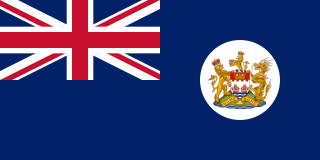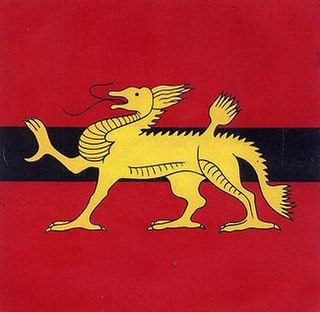
The special administrative regions (SAR) of the People's Republic of China are one of four types of province-level divisions of the People's Republic of China directly under the control of its Central People's Government, being integral areas of the country. As a region, they possess the highest degree of autonomy from China's central government. However, despite the relative autonomy that the Central People's Government offers the special administrative regions, the National People's Congress and its Standing Committee remains capable of enforcing laws for the special administrative regions.

The National Day of the Republic of China, also referred to as Double Ten Day or Double Tenth Day, is a public holiday on 10 October, now held annually as national day in the Republic of China. It commemorates the start of the Wuchang Uprising on 10 October 1911 which ultimately led to the collapse of the imperial Qing dynasty, ending 2,133 years of imperial rule of China since the Qin dynasty and establishment of the Republic of China on 1 January 1912. The day was once held as public holiday in mainland China during the Mainland Period of the ROC before 1949. The subsequent People's Republic of China continues to observe the Anniversary of the Xinhai Revolution at the same date but not as a public holiday, which put more emphasis on its revolutionary characteristics as commemoration of a historical event rather than celebration to the founding of the Republic of China.

Tuen Mun District is one of the 18 administrative districts of Hong Kong. It is the westernmost continental district of Hong Kong. It had a population of 506,879 in 2021. Of these, 64 000 are under the age of 18. Part of the district is the Tuen Mun New Town, which contains one of the largest residential areas in the New Territories.

The Chinese People's Liberation Army Forces Hong Kong Building is the headquarters building of the People's Liberation Army Hong Kong Garrison, located on Lung Wui Road, Admiralty, Hong Kong.

British Forces Overseas Hong Kong comprised the elements of the British Army, Royal Navy and Royal Air Force stationed in British Hong Kong. The Governor of Hong Kong also assumed the position of the commander-in-chief of the forces and the Commander British Forces in Hong Kong took charge of the daily deployment of the troops. Much of the British military left prior to the handover of Hong Kong to China in 1997. The present article focuses mainly on the British garrison in Hong Kong in the post Second World War era. For more information concerning the British garrison during the Second World War and earlier, see the Battle of Hong Kong.

The People's Liberation Army Hong Kong Garrison is a garrison of the People's Liberation Army (PLA), responsible for defence duties in the Hong Kong Special Administrative Region (SAR) since the handover of Hong Kong in 1997.

The Hong Kong Military Service Corps (HKMSC) was a British army unit and part of the British garrison in Hong Kong. Throughout the history of Hong Kong, it has been the only regular British army unit raised in the territory made up almost entirely of Locally Enlisted Personnel (LEP).

Nanyue, was an ancient kingdom founded in 204 BC by the Chinese general Zhao Tuo, whose family continued to rule until 111 BC. Nanyue's geographical expanse covered the modern Chinese subdivisions of Guangdong, Guangxi, Hainan, Hong Kong, Macau, southern Fujian and central to northern Vietnam. Zhao Tuo, then Commander of Nanhai Commandery of the Qin dynasty, established Nanyue in 204 BC after the collapse of the Qin dynasty. At first, it consisted of the commanderies of Nanhai, Guilin, and Xiang.

The Gin Drinkers Line, or Gin Drinkers' Line, was a British military defensive line against the Japanese invasion of Hong Kong during the Battle of Hong Kong in December 1941, part of the Pacific War.

Castle Peak or Pui To Shan (杯渡山) is a 583-metre (1,913-feet)-high peak in western New Territories, Hong Kong. It is also the highest granitic hill in Hong Kong.

Tuen Mun or Castle Peak is an area near the mouth of Tuen Mun River and Castle Peak Bay in the New Territories, Hong Kong. It was one of the earliest settlements in what is now Hong Kong and can be dated to the Neolithic period. In the more recent past, it was home to many Tanka fishermen who gathered at Castle Peak Bay. Tuen Mun is now a modern, mainly residential area in the north-west New Territories. As of 2011, 487,546 residents live in Tuen Mun.

HMS Tamar was the name for the British Royal Navy's base in Hong Kong from 1897 to 1997. It took its name from HMS Tamar, a ship that was used as the base until replaced by buildings ashore.

The Convention between the United Kingdom and China, Respecting an Extension of Hong Kong Territory, commonly known as the Convention for the Extension of Hong Kong Territory or the Second Convention of Peking, was a lease and unequal treaty signed between Qing China and the United Kingdom in Peking on 9 June 1898, leasing to the United Kingdom for 99 years, at no charge, the New Territories and northern Kowloon, including 235 islands.

Gun Club Hill Barracks are barracks in King's Park, or in Jordan, Hong Kong formerly used by British Army garrisons during British colonial rule. The military began using the area shortly after 1860 when the British acquired Kowloon. The barracks are bounded by Austin Road, Jordan Path, Gascoigne Road and Chatham Road South.

Tuen Mun New Town, commonly referred to simply as Tuen Mun, is a satellite town of Hong Kong. It is one of the new towns that were developed by the Hong Kong Government in the New Territories from the 1960s. It was built around the existing rural local centre of Tuen Mun, which has since been referred to as the Tuen Mun Kau Hui and the Tuen Mun San Hui. The new town covers most of the urban area of Tuen Mun District.

The History of Hong Kong under Imperial China began in 214 BC during the Qin dynasty. The territory remained largely unoccupied until the later years of the Qing dynasty when Imperial China ceded the region to Great Britain under the 1842 Treaty of Nanking, whereupon Hong Kong became a British Colony.

Hong Kong is an important port in the Far East and has relied on entrepôt trade to survive its economy for more than a century.

Ngong Shuen Chau Naval Base is part of the People's Liberation Army Hong Kong Garrison and small naval base on Stonecutters Island, Hong Kong. It is home to the South Sea Fleet Squadron #38081 and is a sub-base of the naval squadron of the South Sea Fleet. The area surrounding the base is off limits to civilian ship traffic.

The Han conquest of Nanyue was a military conflict between the Han Empire and the Nanyue kingdom in modern Guangdong, Guangxi, and Northern Vietnam. During the reign of Emperor Wu, Imperial Han military forces formally launched a punitive campaign against Nanyue and successfully conquered it in 111 BC.
This is a list of military parades held in the Hong Kong since 1945.

















